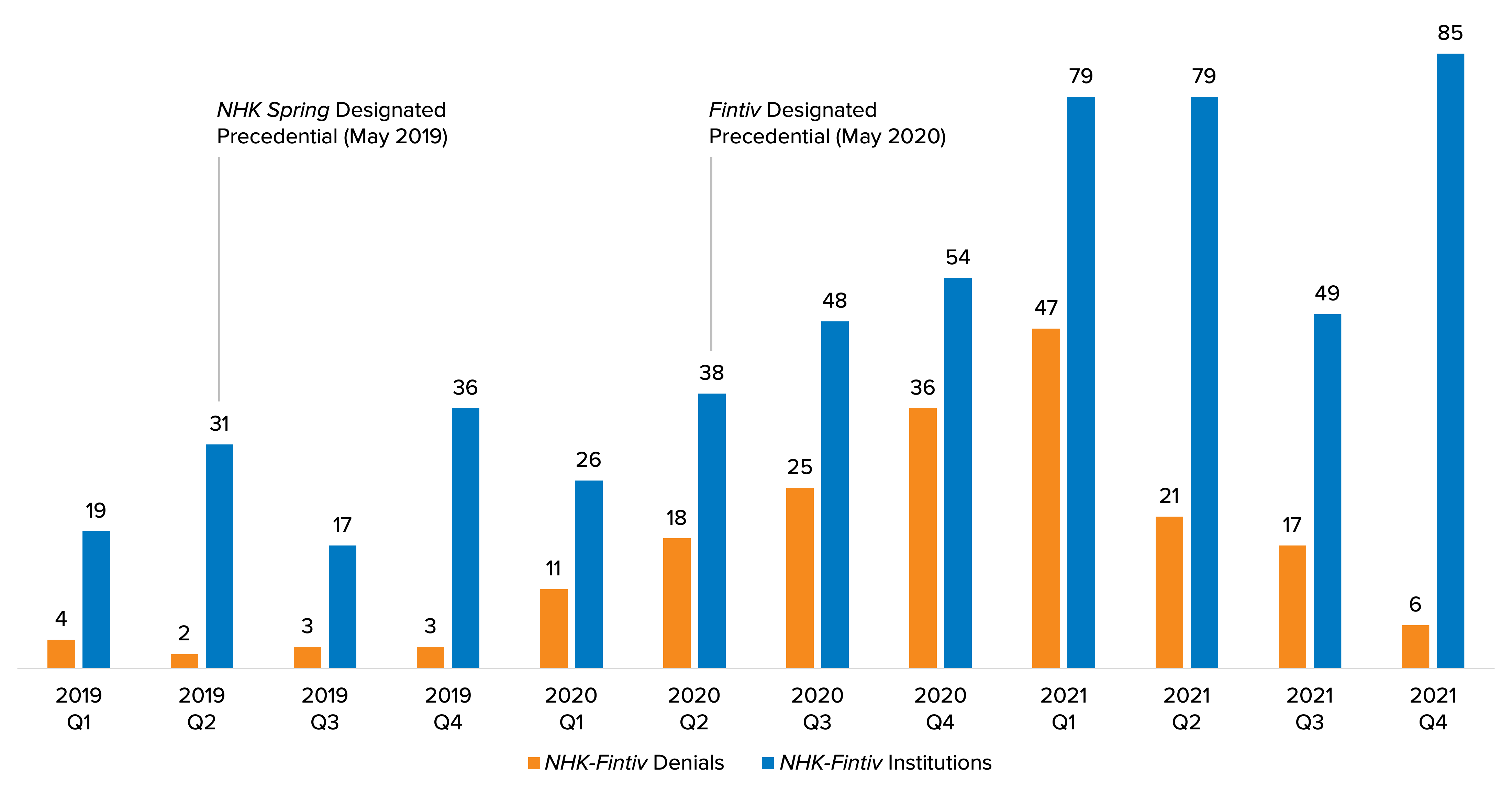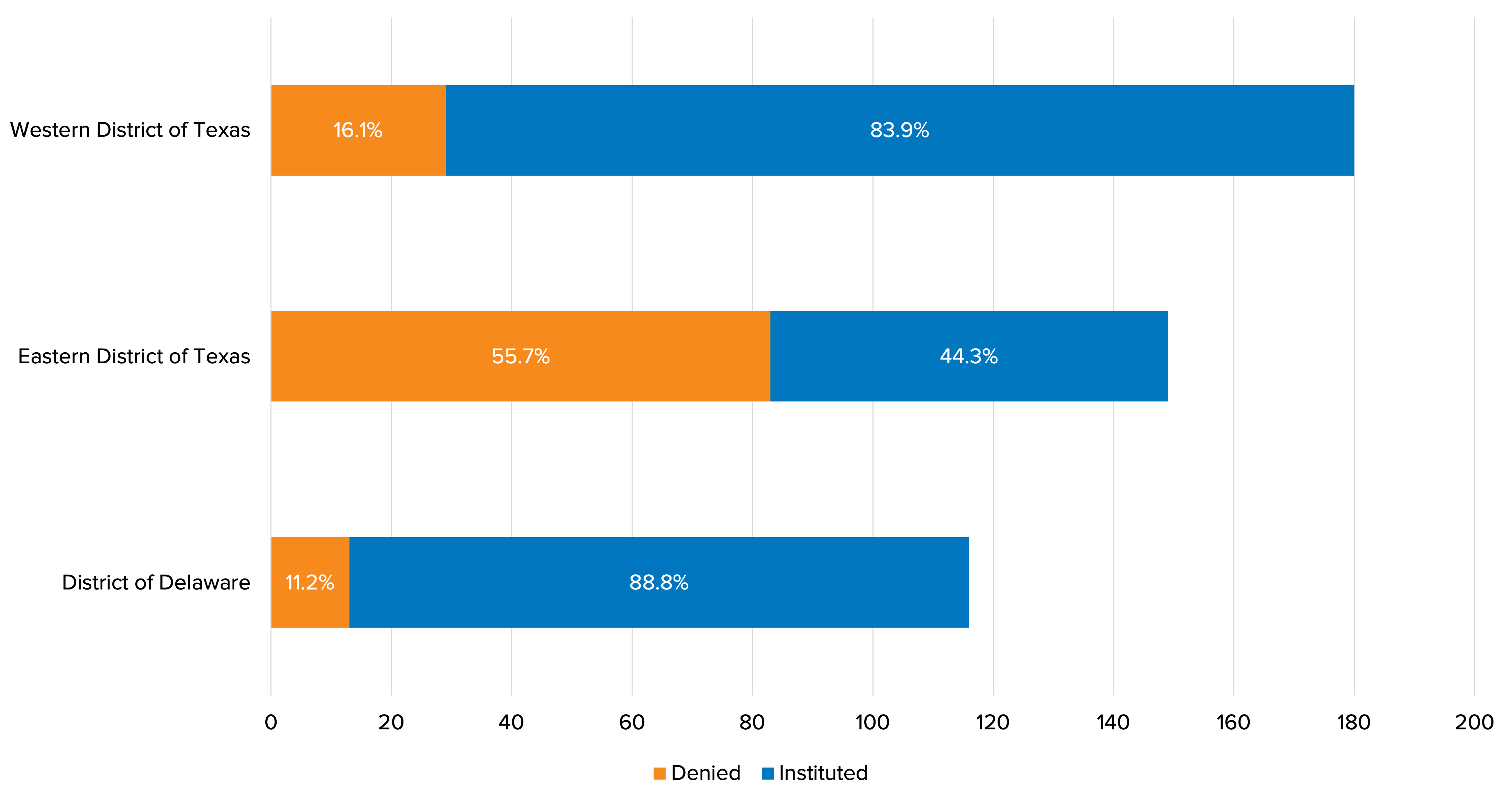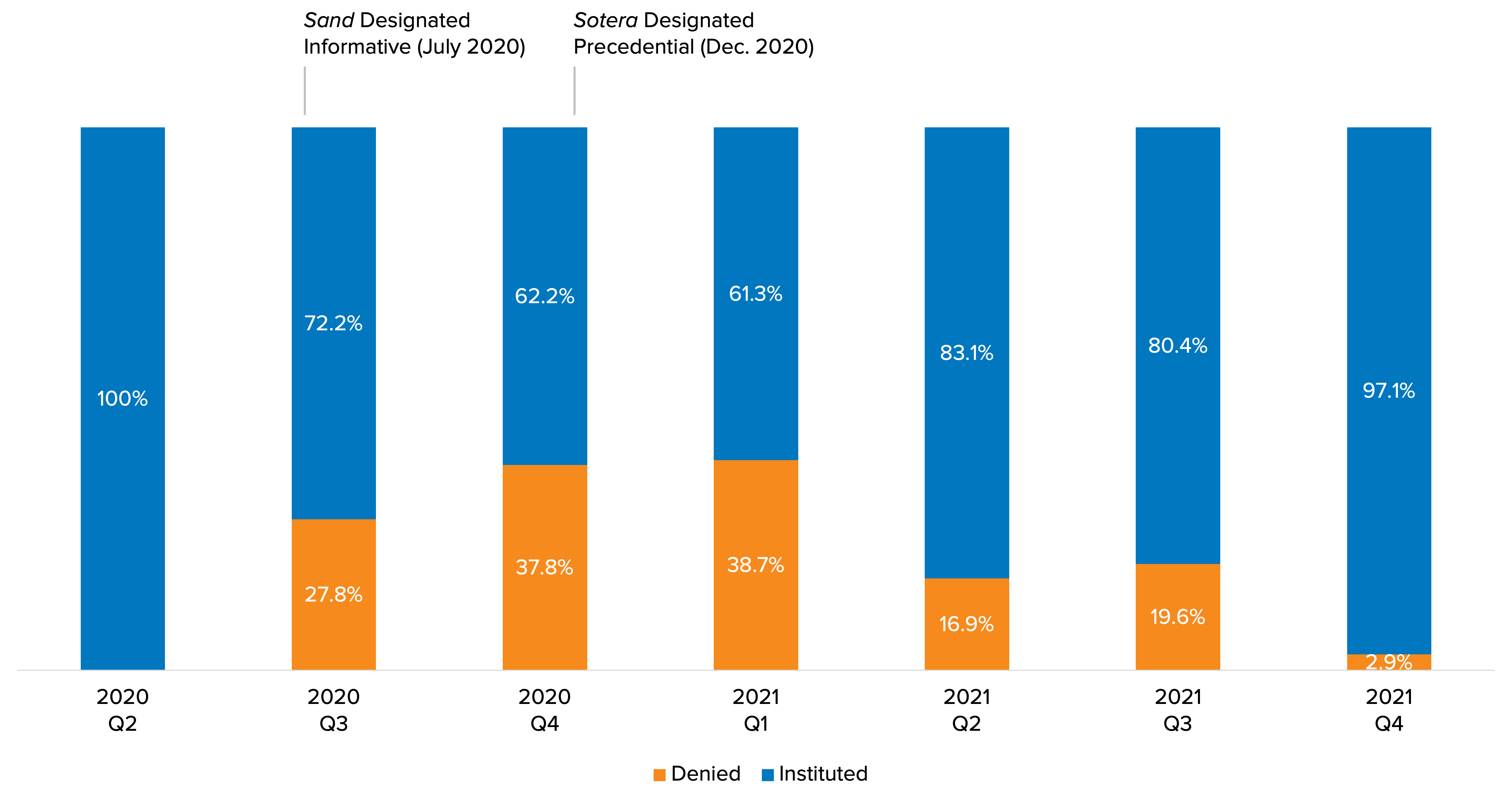Vidal Announces New NHK-Fintiv Procedures to Rein In Discretionary Denials
Ever since USPTO Director Kathi Vidal’s April confirmation, stakeholders have watched closely for signs of how she would address concerns over the NHK-Fintiv rule—the Patent Trial and Appeal Board’s (PTAB’s) practice of discretionarily denying institution in America Invents Act (AIA) reviews based on the status of parallel litigation. Vidal has now taken steps to limit this practice, issuing an interim guidance that in part seeks to mitigate the impact of one of the rule’s most hotly debated factors.
Under that controversial factor (factor two), the PTAB may reject a petition if the district court’s scheduled trial date falls too close to the deadline for the Board’s final validity decision. This can be especially problematic from a strategic perspective because it forces petitioners to file as early as possible—effectively, further compressing the one-year window defendants already have to file an inter partes review (IPR)—based on an aspect of litigation, trial scheduling, that is inherently outside of a petitioner’s control. Moreover, critics of this factor (among them Senator Thom Tillis (R-NC), otherwise an NHK-Fintiv supporter) have faulted the Board for relying on the date when trials are scheduled as opposed to when they ultimately take place, since scheduled dates can often get pushed back due to a variety of factors—a particular problem during the early days of the COVID-19 pandemic.
Vidal’s new guidance acknowledges those concerns, agreeing with critics that because scheduled dates are “unreliable” and frequently change, such a date is “not by itself a good indicator of whether the district court trial will occur before the statutory deadline for a final written decision”. As a result, Vidal established that trial time alone cannot tip the scales toward denial under NHK-Fintiv: “when other relevant factors weigh against exercising discretion to deny institution or are neutral, the proximity to trial should not alone outweigh all of those other factors”. Moreover, Vidal declared that trial dates must instead be considered based on aggregate data on when trials actually take place, stating that the PTAB will now “consider the median time from filing to disposition of the civil trial for the district in which the parallel litigation resides”—apparently based on statistics from the Federal Judiciary according to an accompanying footnote. When parties rely on such data, Vidal stated that the PTAB will also consider factors including the caseload of the judge in the parallel litigation as well as the “speed and availability of other case dispositions”.
Vidal also established a new rule that essentially exempts AIA reviews that are especially likely to succeed from NHK-Fintiv. Specifically, the Director stated that while the PTAB will retain the discretion to deny institution under NHK-Fintiv factor six (considering the merits of the petition) where evidence of invalidity is “merely sufficient to meet the statutory institution threshold”, the Board “should not discretionarily deny institution” for petitions presenting “compelling, meritorious challenges”: “those in which the evidence, if unrebutted in trial, would plainly lead to a conclusion that one or more claims are unpatentable by a preponderance of the evidence”. “This clarification”, explained Vidal, “strikes a balance among the competing concerns of avoiding potentially conflicting outcomes, avoiding overburdening patent owners, and strengthening the patent system by eliminating patents that are not robust and reliable”. She argued that such a rule is consistent with Congress’s intent in creating the PTAB as an alternative to district court validity challenges, and allows AIA reviews to continue in the event that the parallel litigation settles or “fails to resolve the patentability question presented in the PTAB proceeding”.
Vidal additionally clarified that the NHK-Fintiv factors only apply to parallel litigation in district court—and not in International Trade Commission (ITC) proceedings. Though the language and substance of the factors “focus on the interplay between IPRs and district court litigation” (referring throughout to “court[s]”), Vidal noted that the PTAB had nonetheless, “in the past, denied AIA reviews based on parallel ITC investigations”. However, Vidal indicated that this had been improper, since “[u]nlike district courts, the ITC lacks authority to invalidate a patent and its invalidity rulings are not binding on either the Office or a district court”. Since the ITC cannot “conclusively resolve” an invalidity claim, requiring parties to turn to district courts or the PTAB, denying institution due to a parallel ITC action “will not necessarily minimize potential conflicts between PTAB proceedings and district court litigation”. While the PTAB had already stopped discretionarily denying AIA reviews based on ITC actions for this reason, Vidal noted that her “memorandum memorializes this practice”: “The PTAB will not discretionarily deny petitions based on applying Fintiv to a parallel ITC proceeding”.
Moreover, Vidal gave her seal of approval to the PTAB’s practice of allowing parties to stipulate around NHK-Fintiv factor four, under which the Board may deny a petition if it contains the “same or substantially the same claims, grounds, arguments, and evidence” as a district court invalidity challenge. That practice has arisen as a result of two key PTAB decisions. In Sand Revolution II v. Continental Intermodal Group – Trucking (issued May 2020; designated as informative that July), the PTAB granted institution after the petitioner agreed not to assert the same invalidity grounds in district court that it did in its IPR petition. That same December, the Board accepted an even broader type of stipulation in its Sotera Wireless v. Masimo decision (designated as precedential two weeks later), after the petitioner informed the district court that it would not pursue “any ground raised or that could have been reasonably raised in an IPR” after institution. Vidal endorsed the latter category (calling them “Sotera [s]tipulations”, described in related materials as “Sand/Sotera stipulations”), explaining that these “mitigate[] concerns of potentially conflicting decisions and duplicative efforts between the district court and the PTAB”. As a result, Vidal stated that “the PTAB will not discretionarily deny institution of an IPR or [post-grant review (PGR)] in view of parallel district court litigation where a petitioner stipulates not to pursue in a parallel district court proceeding the same grounds as in the petition or any grounds that could have reasonably been raised in the petition”.
Vidal’s memorandum indicates that more changes may be coming as well, given the flood of feedback received by the USPTO through a late 2020 Request for Comment on its discretionary denial practices. In light of those comments, Vidal stated that the USPTO “is planning to soon explore potential rulemaking on proposed approaches through an Advanced Notice of Proposed Rulemaking”. Details on those proposed approaches, though, were not provided.
Companion Study Illustrates NHK-Fintiv’s Impact
Also released alongside Vidal’s memorandum was a USPTO study on parallel litigation that provided data on how the NHK-Fintiv rule has played out in practice (with an accompanying executive summary as well an appendix providing tabular data and methodology). The study revealed that after the Fintiv decision was designated as precedential in May 2020 (with its companion NHK Spring decision having been so designated one year prior), parallel litigation was raised in 40% of all AIA review proceedings (meaning that either the institution decision analyzed NHK-Fintiv, or the patent owner argued for discretionary denial under NHK-Fintiv prior to the denial of institution on other, merits-related grounds). Additionally, the study found that NHK-Fintiv denials peaked in the first quarter of 2021 and “dropped significantly afterwards”. Indeed, the data shown in the study indicate that the PTAB issued just six NHK-Fintiv denials in Q4 2021, compared to 85 decisions granting institution after analyzing NHK-Fintiv. (Note that the time periods discussed in the study refer to the USPTO’s fiscal year, which begins on October 1—so, e.g., the second quarter of fiscal year 2021 corresponds to Q1 2021 for the calendar year. This article, including the graphs below, adapts fiscal year dates to the calendar year.)
NHK-Fintiv Outcomes (AIA Review Institution Decisions)

The USPTO also included a breakdown of NHK-Fintiv decisions by the venue of parallel district court cases, focusing on the three districts accounting for the bulk of such decisions: the Western and Eastern Districts of Texas and the District of Delaware. That breakdown revealed one rather surprising conclusion. While the Western District of Texas has been a focal point in the NHK-Fintiv debate due to District Judge Alan D. Albright’s focus on scheduling early trial dates—and, indeed, his venue was the one most discussed in NHK-Fintiv decisions—it had not seen an NHK-Fintiv denial based on parallel litigation since August 2021. West Texas was also the district with the lowest rate of NHK-Fintiv denials among the top three, at 16.1% (or 29 denials out of the 180 total institution decisions counted). The Eastern District of Texas had a much higher denial rate at 55.7% (or 83 of 149 total decisions), with Delaware the lowest at 11.2% (13 of 116 decisions total).
NHK-Fintiv Outcomes by District, 2019-2021 (AIA Review Institution Decisions)

The study further quantified the impact of the Sand/Sotera stipulations endorsed in Vidal’s guidance, showing that challengers agreeing to such estoppel in district court are now much more likely to have their petitions instituted. In particular, the data show that for institution decisions that noted such stipulations, the grant rate has increased significantly—going from 61.3% in Q1 2021 (the first full quarter since the Sotera decision was designated as precedential) to 97.1% in Q4. The statistics also reflect a corresponding increase in the number of institution decisions noting such stipulations.
AIA Review Institutions Noting Sand/Sotera Stipulations

Congress Weighs Legislative Reform
The new guidance comes as Congress considers legislative proposals to reform the PTAB—including a new Senate bill that would eliminate the NHK-Fintiv rule. That bill, the Patent Trial and Appeal Board Reform Act of 2022, was introduced on June 16 by Senators Patrick Leahy (D-VT), John Cornyn (R-TX), and Thom Tillis (R-NC). The proposed law also includes provisions designed to counter alleged gamesmanship at the PTAB and would pay the expert witness fees and attorney fees for certain “small” and “micro” entities that have not asserted their challenged patents in litigation. In announcing the bill, Senator Tillis described it as a “carefully crafted compromise requiring sacrifices from both sides of the issues”, adding at a June 22 hearing on PTAB reform, “[i]f you don't like the compromise we’ve come up with, tell us. But don’t just tell us you hate it. Give us ideas on how to write a better bill that will, in your opinion, be a better compromise”.
Alleged abuses of the patent system, the need to encourage innovation, and a variety of specific PTAB issues were at the forefront in Kathi Vidal’s confirmation process, during which Senator Tillis and other members of the Senate Judiciary Committee questioned her about NHK-Fintiv, patent eligibility, “judge shopping”, SEP licensing, and a variety of other patent issues. For details on Vidal’s responses in her capacity as a then-nominee, see “Vidal Details Views on Key Patent Issues in Written Responses to Senate Committee” (December 2021).